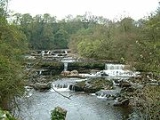
Aysgarth Falls
Encyclopedia
.jpg)
.jpg)


Waterfall
A waterfall is a place where flowing water rapidly drops in elevation as it flows over a steep region or a cliff.-Formation:Waterfalls are commonly formed when a river is young. At these times the channel is often narrow and deep. When the river courses over resistant bedrock, erosion happens...
s, surrounded by forest and farmland, carved out by the River Ure
River Ure
The River Ure is a river in North Yorkshire, England, approximately long from its source to the point where it changes name to the River Ouse. It is the principal river of Wensleydale, which is the only one of the Dales now named after a village rather than its river...
over an almost a one-mile stretch on its descent to mid-Wensleydale
Wensleydale
Wensleydale is the valley of the River Ure on the east side of the Pennines in North Yorkshire, England.Wensleydale lies in the Yorkshire Dales National Park – one of only a few valleys in the Dales not currently named after its principal river , but the older name, "Yoredale", can still be seen...
in the Yorkshire Dales
Yorkshire Dales
The Yorkshire Dales is the name given to an upland area in Northern England.The area lies within the historic county boundaries of Yorkshire, though it spans the ceremonial counties of North Yorkshire, West Yorkshire and Cumbria...
of England
England
England is a country that is part of the United Kingdom. It shares land borders with Scotland to the north and Wales to the west; the Irish Sea is to the north west, the Celtic Sea to the south west, with the North Sea to the east and the English Channel to the south separating it from continental...
, near the village of Aysgarth
Aysgarth
Aysgarth is a village and civil parish in Wensleydale, in the Richmondshire district of North Yorkshire, England. The village is in the Yorkshire Dales National Park, about sixteen miles south-west from Richmond...
. The falls are quite spectacular during wet weather, as thousands of gallons of water cascade over the series of broad limestone steps.
Aysgarth Falls have attracted visitors for over 200 years; Ruskin
John Ruskin
John Ruskin was the leading English art critic of the Victorian era, also an art patron, draughtsman, watercolourist, a prominent social thinker and philanthropist. He wrote on subjects ranging from geology to architecture, myth to ornithology, literature to education, and botany to political...
, Turner
J. M. W. Turner
Joseph Mallord William Turner RA was an English Romantic landscape painter, watercolourist and printmaker. Turner was considered a controversial figure in his day, but is now regarded as the artist who elevated landscape painting to an eminence rivalling history painting...
and Wordsworth
William Wordsworth
William Wordsworth was a major English Romantic poet who, with Samuel Taylor Coleridge, helped to launch the Romantic Age in English literature with the 1798 joint publication Lyrical Ballads....
visited, all enthusing about the falls’ outstanding beauty. The upper fall was featured in the film Robin Hood: Prince of Thieves
Robin Hood: Prince of Thieves
Robin Hood: Prince of Thieves is a 1991 American adventure film directed by Kevin Reynolds. Kevin Costner heads the cast list as Robin Hood...
.
In addition to the falls, there are walks which wind through the wooded valley
Valley
In geology, a valley or dale is a depression with predominant extent in one direction. A very deep river valley may be called a canyon or gorge.The terms U-shaped and V-shaped are descriptive terms of geography to characterize the form of valleys...
, offering views of the river and falls. Wild flowers appear in the spring and summer, and wild birds, squirrels
Eastern Gray Squirrel
The eastern gray squirrel is a tree squirrel in the genus Sciurus native to the eastern and midwestern United States, and to the southerly portions of the eastern provinces of Canada...
and deer
Deer
Deer are the ruminant mammals forming the family Cervidae. Species in the Cervidae family include white-tailed deer, elk, moose, red deer, reindeer, fallow deer, roe deer and chital. Male deer of all species and female reindeer grow and shed new antlers each year...
may also be seen. Nearby is St Andrew's church, which has a large churchyard, reputed to be the largest in England. The church has a medieval painted wooden screen rescued from the destroyed Jervaulx Abbey
Jervaulx Abbey
Jervaulx Abbey in East Witton near the city of Ripon, was one of the great Cistercian abbeys of Yorkshire, England, founded in 1156. Initially a Savigniac foundation, the abbey was later taken over by the Cistercian order and responsibility for it was taken by Byland Abbey. Originally founded in...
.
The name originates from old Norse
Old Norse
Old Norse is a North Germanic language that was spoken by inhabitants of Scandinavia and inhabitants of their overseas settlements during the Viking Age, until about 1300....
, meaning the open space in the oak trees.
It was featured on the television programme Seven Natural Wonders
Seven Natural Wonders
Seven Natural Wonders was a television series that was broadcast on BBC Two from 3 May to 20 June 2005. The programme took an area of England each week and, from votes by the people living in that area, showed the 'seven natural wonders' of that area in a programme.The programmes were:The series...
as one of the wonders of the North.

